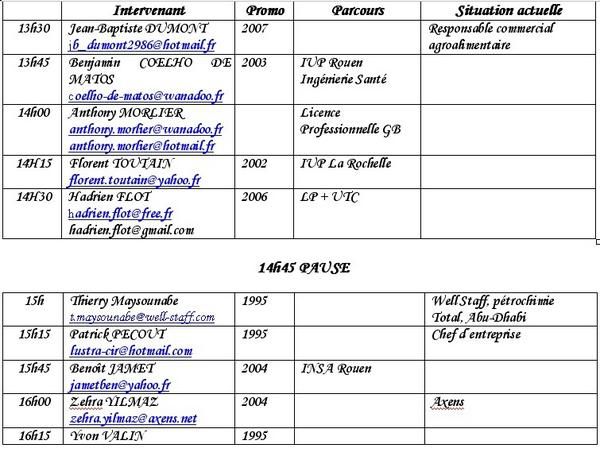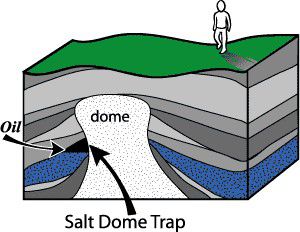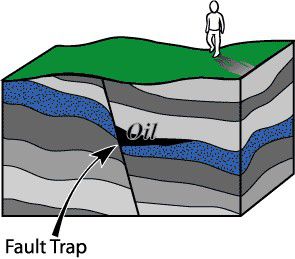



III. Entrapment processes of oil and gas.
An Oil trap is an area where oil or gas is concentrated and will accumulate but be restrained from moving or migrating any further. Such traps must also be impermeable, thus providing an effective seal for the hydrocarbons present, e.g. in a permeable reservoir rock such as a porous sandstone or fracture limestone.
Structural traps must exist before hydrocarbon generation ceases.
For oil and gas accumulations, seal and reservoir must be of the required geometry and set in a relative position to form a trap.
For traps to occur, a suitable combination of rock types is deposited in a particular environment, e.g. where a reservoir rock of permeable river sand is sealed by clays which accumulate in the surrounding swamps.
However most traps are actually formed by a complex sequence of events. Four important conditions must exist for the entrapment of oil and gas.
- A subsurface source rock. Rock which has generated gas or oil at some time in the geological past.
- A subsurface reservoir rock. Rock which retains gas or oil so that it can be produced in a cost-effective manner.
- A trap or high point. An area where oil or gas is concentrated and will accumulate but be restrained from moving or migrating any further. Such traps must also be impermeable, thus providing an effective seal for the hydrocarbons present.
- Sufficient quantity. There must also be enough oil or gas to make its extraction profitable. The reservoir must have minimum porosity, permeability and have a minimum thickness, depending on local conditions present.
A. Traps.
A trap may be structurally formed by natural processes of deformation of the rock caused by movement of the Earth's plates, e.g. a folded arch, or a break (fault), or a stratigraphic trap which formed when the rock was originally deposited, or when part of the reservoir rock was removed by erosion (an angular unconformity).
The trap therefore, would be the high point in the reservoir rock where the gas and oil becomes concentrated along the reservoir rock layer and is prevented from leaking out. In reservoir rock traps, the fluids cannot travel any further and will separate according to their density. The gas rises to the top, the oil remains in the middle and the water sinks to the bottom.
B. Deformation of sedimentary rocks.
General.
The key to the entrapment of oil and gas is to understand the interpretation of the deformation of sedimentary rocks. In general terms, sedimentary rocks can be described as originally deposited at, or close to, the horizontal in layers or shallow slopes called strata or beds.
An exception is limestone reefs which have grown.
Sedimentary rocks that are tilted have been disturbed from their original horizontal orientations. When stresses are put on the rock formations they will deform by either: bending into folds and breaking along joints or faults.
Styles of rock deformation.
The most common styles of rock deformation are given below. Each item is briefly described in this section:
- Anticlines and Synclines.
- Domes and Basins.
- Faults and Joints.
- Salt.
Salt can play a major role not only as a seal but also as a creator of structural trap, e.g. when rocks are domed over rising salt masses.
a. Anticlines and synclines - folds.
An anticline is best described as an upward arch of rock and a syncline as a downward arch of rock.

Most anticlines and synclines are not level but have been tilted somewhat in relation to the surface of the Earth. These structures are called plunging folds. Both structures can form ideal oil/gas traps.
Domes have the oldest rocks in the centre of its structure where as basins have the youngest rocks in the centre, e.g. anticline domes such as El Alamein (Libya).

The dome is a natural gas and oil trap because of the high point formed on the reservoir rock.
Sediments dipping uniformly either in one direction or on one side of a fold are known as monoclines, or homoclines.
c. Faults.
Faults are breaks in the rocks in which one side has moved relative to the other. Movement of rocks along a fault often causes shock waves called earthquakes. A typical fault will move numerous times during its history. Stresses build up for a period of time until the fault moves to relieve the stresses. This repeats until after a period of time the fault eventually becomes inactive.
Faults are classified on the basis of the relative movement of both sides.

C. Unconformities.
Sedimentary rocks were deposited in ancient geological times when shallow seas covered the land. When the sea level was lower and the land was exposed to erosion, unconformities, i.e. buried erosion surfaces, were created and there are three important types to be considered.
- Disconformity.
Disconformity is a short lived (10's to 10,000's years) break in deposition of sediments.
A disconformity is an unconformity which is best typified by an ancient river channel that has been filled with sand. This would have been created during a geological period of time when the land was exposed and a river shifted into the area and eroded a channel into the underlying rocks.
The channel then became filled with sand and the river shifted to another area, abandoning the old channel. Later in time, the seas would cover the area burying the river channel.
River channels would not be large features, but because of this, disconformity, although common in sedimentary rocks, are not large features.
- Angular Unconformity.
Angular unconformity is a longer lived break in sediment deposition (may be 100's million years). It is a very old surface in which the strata below the unconformity are tilted at an angle to the strata above the unconformity. There are generally 4 stages recognised in producing such an unconformity.
A geologist may recognise an unconformity while drilling, when rock formations expected have not been encountered, during the progress of the well, e.g. gap of sediment.
- Unconformity Petroleum Traps.
If a potential reservoir of sandstone or limestone is tilted, eroded flat by the unconformity and then covered with a rock, which acts as a seal such as shale, a trap is formed.
When the gas and oil form later, it migrates up through the spaces of the reservoir rock until it reaches the angular unconformity surface where it is trapped.
There, just below the angular unconformity surface, the gas and oil accumulate.
Because angular unconformity cover large areas in the subsurface, angular unconformity traps tend to form giant oil and gas fields, such as in the Northern Regions of Africa.
Limestones also form an ideal entrapment for oil and gas. Most of the worlds oil and gas in the Middle East is trapped in limestone structures.
IV. Conclusions.
To conclude, it is essential to remember that a reservoir entrapped oil and/or gas, and water (always present). The gas is raised to the top of the reservoir, the oil is maintained in the middle and the water (formation water) sank to the bottom.
Every reservoir is capped by a permeable rock, most of the time being shales or limestones.
The oil distribution in the rock (also called formation) is not systematically homogeneous, and the layers containing oil are not systematically horizontal. That is why Exploration companies use seismic techniques and rill exploration well (low diameter) before deciding to drill a production well.
Document in English, of course ...
I. Introduction.

Anaerobic conditions are required to prevent oxidation of the organic matter and to reduce bacterial degradation accumulation loss.
Much organic source is found in stratified water bodies where oxygenated surface waters permit plankton growth.
The accumulation of such matter is aided when circulation of water is restricted to some extent, so that an oxygen deficiency exists on the bottom sediments to decompose the organic material.
As a result of poor circulation and restriction, the water bodies become stratified and the sea or lake floor may become oxygen deficient (dysaerobic) or totally anoxic. Dysaerobic conditions occur where the sea floor is within the oxygen minimum zone, generally in a depth range of 100-1000 m.
The low O2 results from bacterial decomposition of organic matter sinking down from fertile oxic surface waters. Where there is oxygen deficiency on the sea floor, organic matter will be preserved.
In oil shales, typically 4 - 50 w.% of rock volume will be produced. This represents approximately 50 - 700 litres of oil per metric ton.
Most of the Earth's oil and gas is thought to have been produced during the Jurassic and Cretaceous periods with less from the Carboniferous and Tertiary periods.
Preservation.
In many depositional environments, organic matter is decomposed and destroyed at sediments surface. If the rate of organic matter accumulation is high, it can be preserved. The anoxic bottom waters allow preservation of organic matter.
Where there is oxygen deficiency on the sea floor, organic matter will be preserved.
Where there are anoxic conditions on the sea floor, there is usually too much H2S in the water and organisms are absent.
Generation.
For any given depth of burial or temperature to which it has been heated, the type of source rock controls the chemical composition of oil and gas produced.
A diverse group of rocks contains organic matter that is mostly insoluble in organic solvents. Organic matter produced is largely Kerogen.
The most common source rock is black shale, though some oil shales are rich (Siltstones) and another abundant source rock is organic rich (Limestones). The organic matter in oil source rocks is finely disseminated so that the organisms from which it was formed are difficult to identify.
Diagenesis of organic material can begin very early at shallow burial depths of 10's to 100's of metres and several millions of years in age, e.g. methane produced through bacterial fermentation. Continuing burial diagenesis of deposited organic matter leads to the formation of Kerogen, the type dependant on the organic matter contained in the source. Differences in composition of Kerogen can lead to production of largely gas or to a variety of oil types.
Burial to temperatures of 50 - 90°C causes thermocatalytic reactions in the Kerogen resulting in the main constituents of crude oil being generated and matured. With increasing temperature, more and more oil is generated until a maximum is reached. With further increasing temperature oil generation reduces, gas quantities increase.
Time.
Time is a vital factor in source rock maturation. Higher temperatures and greater burial depths are required for generation from younger rocks compared with older rocks which can thus reach maturity at lower temperatures.
The Oil "maturation" Window.
Finally in maturation, the "Oil Window" is considered the area of depth and range of temperature in the Earth where oil is matured from source rocks. In the average sedimentary basin, oil maturation begins at 120 F (50°C) peaks at 190 F (90°C) and ends at 350 F (175°C). Above and below the Oil Window natural gas is generated, e.g. above we find biogenic gas, and below it, we find thermal gas.
In different regions it depends on the geothermal gradients within the Earth's crust.
For an average sedimentary basin the heat gradient is 1.4 F/100 ft (30°C/1000 m, in the North Sea), with the Oil Window starting at 5000 ft (1500 m) and ending at approx. 20,000 ft (6000 m).
Increasing temperatures convert the heavy hydrocarbons into lighter ones and ultimately to gas. At higher temperatures above 500 F (260°C), the organic material is carbonised and destroyed as a source material. Consequently, if source beds become too deeply buried, no hydrocarbons will be produced.
However, this also varies with the age of the sediments as crude oil cannot exist below the Oil Window. For the reasons given therefore, some sedimentary basins are unproductive, since the basin might not have an organic rich source rock that could generate petroleum or may never have been buried in the Oil Window.
Also, some basins are gas prone, that is they only produce natural gas due to nature of source, e.g. coaly source rocks of Eocene in parts of Indonesia/Far East.
III. Migration processes of oil and gas.
Potential oil and gas sediments accumulate as a mixture of grains, water and organic content. As they are buried and compacted, fluids and/or gas mature, will increase in volume, and are squeezed out of the source rocks by the resulting forces that exist.
Migration is the process of the oil and gas moving away from the source rock. This is a slow process, i.e. perhaps a few kilometres over a period of millions of years.
Migration is caused by burial, compaction, and increase in volume and separation of the source rock constituents.
There must be space 'porosity' within the rocks to allow for movement. In addition, there should be 'permeability' within the rocks to allow for flow.
Burial.
As the source rock is buried deeper in the Earth, increasing pressure (overburden) of the overlying rocks squeezes and compacts the rock to provide the driving forces to expel water, oil and gas.
The mineral grains do not compact but their pore spaces are decreased. Any petroleum generated is therefore squeezed out of the source rock spaces.
Increase in volume.
The maturation of a liquid or gas from a solid, causes an enormous increase in volume which may cause fracturing of the source rock. The hydrocarbons generated, therefore, escape upwards through such fractures that are created.
Compaction.
Compaction of the source rock beds by the weight of the overlying rocks provides the driving mechanism to expel the hydrocarbons causing them to move, where they will take the easiest route i.e. (through the most porous beds or fractures) moving to regions of lower pressure (that normally would be at shallower depths).
Separation.
Gravity separation of gas, oil and water takes place in reservoir rocks that are usually water saturated. Consequently, petroleum is forever trying to rise until it is trapped (by non permeable rocks, usually shales) or escapes at the earth's surface.
Water, Oil and gas will only migrate through permeable enough zones where spaces between rock particles deposited or generated are interconnected and large enough to allow fluid movement to an entrapment point.
Primary and secondary migration
Primary migration is the process of movement from source rock.
Secondary migration is movement to or within the reservoir entrapment.
a. Primary Migration.
Primary migration is the transportation of water, oil and gas out of the compacting sediments, e.g. when source muds are first deposited they consisted of 70-80% water. What is left are solids such as clay materials, carbonates particles or fine grained silica.
As sediments build up to greater thickness in sedimentary basins, water is squeezed out by the weight of the overlying sediments. Under normal hydrostatic pressure (0.445 psi/ft ), the clays lose porosity and the pore diameters shrink as shown below.
Depth porosity pore diameter
(m) (%) (nm)
610 27 -
2000 15 10.0
3000 9 5.0
4000 6 2.5
5000 4 1.5
It is also important to note that fluids tend to move toward the lowest potential energy. Initially this is upwards, but as compaction progresses, there is lateral as well as vertical movement.
The primary migration of oil from source to reservoir is as follows:
1. Water flows towards the lowest potential energy.
2. Clay muds often have abnormal pressure because they are slow to release water.
3. Avenues of migration during basing compaction are:
- Sandstones
- Unconformities
- Fracture / Fault systems
- Biothermal reefs.
b. Secondary Migration.
In secondary migration, the oil droplets are moved about within the reservoir to form pools.
Secondary migration can include a second step during which crustal movements of the earth shift the position of the pool within the reservoir rock.
Accumulations can be affected by several, sometimes conflicting, factors:
- Buoyancy causes oil to seek the highest permeable part of the reservoir, capillary forces direct the oil to the coarsest grained area first, then successively into finer grained areas later.
- Any permeable barriers, in the reservoir, channel the oil into somewhat random distribution.
- Oil accumulations in carbonate rock are often erratic because part of the original void spaces have been plugged by minerals introduced from water solutions after rock is formed.
- In large sand bodies, barriers formed by thin layers of dense shale may hold the oil at various levels. With crustal movement of the earth, accumulations are shifted away from where they were originally placed.
- Faults sometimes cut through reservoirs destroying parts or shift them to different depths.
- Uplift and erosion bring accumulations nearer to surface where lighter hydrocarbons may evaporate.
- Fracturing of the cap rock may allow accumulations to migrate vertically to much shallower depth.
Wherever differential pressures exist and permeable openings provide a path, petroleum will move.
Once the water, oil and gas migrates into the trap, it separates according to density. Gas being the lightest, goes to the top of the trap to form the free gas cap. Oil goes to the middle and water that is always present, on the bottom. The oil portion of the trap is saturated with a certain percentage of oil and water.
Vertical migration via faults and fractures is also possible, this has led to many of the large oil accumulations, such as that found at shallow depths in Bolivar, Venezuela, and Northern Iraq.
In other cases, such as in Arabia, migration over relatively long distances has to take place by movement up dip within a porous bed until a trap was encountered.
Next module: entrapment of O&G
Next step of mud engineering position is the MUD SUPERVISOR. Few of mud engineers turn to this position, and most of them have already 15 years experience, but some exceptions can exist sometimes ... Work, learn continuously and you can get this position.
Job description :
- Helps to prepare programs and procedures (SDI) for fluids (including Completion fluids) and cements.
- Ensures proper treatment of discharge produced by drilling and well operations, ensure that all products used are environmentally friendly and follow up the modifications on rig equipment related to fluid and cement.
- Helps to supervise on a daily basis Mud & Cement operations, validate the daily mud and the cement reports, write and issue all required standard technical report related to mud and cement for the final well report.
- Participate in the studies related to mud and cement operations and performance improvement.
- Helps to provide technical solutions when unexpected operational difficulties arise, make sure they are efficient and practical when it comes to implementation on the Field.
- Anticipate needs, ensure the availability of all material and products on rig site, including needs for emergency situations.
- Help to coordinate all tasks related to fluid and cement operations and engineering within the scope of the development program of the company's offshore and onshore operations.
- Optimize the activities of providers and assess their performance and follows up all the quality controls tests requested from contractors or from Operator's HQ.
- Participate in the technical part of call for Tenders and the bidder list, of fluid and cement call for tenders and manage corresponding contracts, check the compliance of the invoices with the services performed and with the contractual terms and conditions.
Education: University degree in Chemistry /Chemical Engineering + Experience
Professional experience:
- Good knowledge of mud and cement products/additives as well as completion fluids.
- skills: Computer literate, fluent English.
mud supervisor job description
To begin in the oil businees, chemists can decide to become Mud Engineers (US name), i.e. Drilling Fluids Technician.
I told you aleady good commands of English are compulsory in our jobs. So below is the mud engineer's scope of work in English.
Job Description: Responsible for designing, building and maintaining the various fluid systems associated with the drilling and the completion of wells.
Essential Duties / Responsibilities:
- Represent the company and the operator’s best interest through accurate, polite in-depth interaction with pertinent personnel by demonstrating current industry level of expertise.
- Perform complete, accurate and timely well-site analysis of all drilling fluids parameters required by the company and/or the operator.
- Participate in pre and post-well planning and presentations.
- Maintain accurate and timely maintenance of drilling fluids records. (Ex: Mud Reports, Materials Concentrations Form, Drilling Fluids Recaps, and any other records or reports requested by the company and/or operator), among which:
- Responsible for staying with the operator to solve any problems which occur at the drilling site until the problem is resolved. (Ex: Lost Circulation, Gas Kicks, Sever Chemical contamination, etc.)
- Strongly participates to cementing operations (double-check of calculations, preparation of pits, density confirmation, sampling, rheology, salilnity of mixing water, cleaning pits, spacers, ...)
- Stock handling
- Service/job tickets
Evolution:
Position starts with junior mud engineer (oftrn night position), then Senior Mud engineer (mostly day position).
Experienced mud engineer can become Mud Supervisor if adequate skills (see description elsewhere). Next step is Fluids, Cement & Wastes Management Superintendent.
Basic Education:
- Chemistry/Chemical Enginneering degree
- Mud School required (contact WellStaff)
''mud engineer job description''

A la fin de mes études, je m'étais fixé un but: évoluer dans le monde du pétrole. J'étais attiré par l'aspect "bourlingueur" de ces métiers, par l'aspect poly-culturel, par l'aspect technique, et aussi disons-le clairement par un aspect financier non négligeable.
Mais vouloir et avoir une bonne formation ne suffit pas. Il faut aller au-delà de la simple démarche de recherche d'emploi: ce secteur, plus que d'autres peut être, est un milieu de combat où l'on doit faire continuellement ses preuves, montrer toujours plus sa motivation, et AVOIR LA CHANCE DE CROISER LES BONNES PERSONNES.
Pendant des années, et alors même que mon profil se prêtait parfaitement aux métiers techniques du Pétrole, les portes se refermaient les unes après les autres. Certes je travaillais et mon CV était intéressant, mais mon projet professionnel n'avançait pas ... jusqu'à ... ma rencontre avec les dirigeants et fondateurs de ce qui n'était alors encore qu'une toute petite société, mais quel dynamisme ! Et quelle envie d'ouvrir les portes du métier aux jeunes français ... Cette société se nomme WellStaff, et mon évolution personnelle et professionnelle est fortement liée à l'état d'esprit qui anime Marc, Edmond et Jean-Jacques entre autres (que les autres associés, consultants et salariés ne m'en veuillent pas de ne pas être cités ici: nous sommes trop nombreux aujourd'hui ... lol).
Aujourd'hui, je suis Consultant via Well-Staff dans le secteur Pétrolier. Well-Staff étant aussi un organisme de formation agréé, je suis aussi formateur pour le secteur des Fluides et Ciments, ainsi que le Traitement de la Production O&G.
Vous pouvez vous rendre sur le site de la société: www.well-staff.com
La philosophie qui caractérise Well-Staff, dont je parlais plus haut, est d'aider ceux qui désirent intégrer ces métiers, en particulier les jeunes, et de créer un réseau d'experts qui s'accompagneront les uns les autres dans leurs missions respectives.
C'est cette vision qu'a WS qui m'a permis d'arrivr là où j'en suis, et je partage à 2000% ces idées. Sur ce blog, vous trouverz donc ci et là des infos qui pourront vous aider, soit à vous former, soit à trouver des contacts, soit même à aider d'autres personnes.
A bientôt